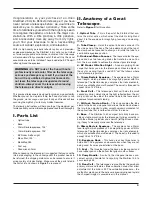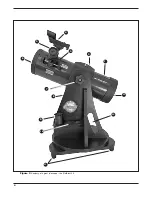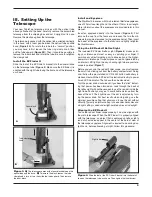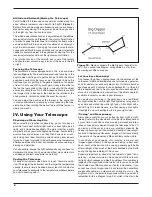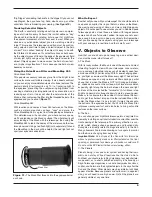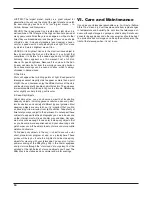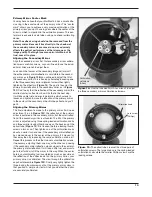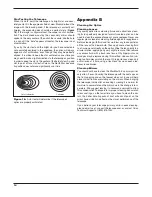
10
JUPITER: The largest planet, Jupiter, is a great subject for
observation. You can see the disk of the giant planet and watch
the ever-changing positions of its four largest moons -- Io,
Callisto, Europa, and Ganymede.
SATURN: The ringed planet is a breathtaking sight when it is
well positioned. The tilt angle of the rings varies over a period of
many years; sometimes they are seen edge-on, while at other
times they are broadside and look like giant “ears” on each side
of Saturn’s disk. A steady atmosphere (good seeing) is neces-
sary for a good view. You will probably see a bright “star” close
by, which is Saturn’s brightest moon, Titan.
VENUS: At its brightest, Venus is the most luminous object in
the sky, excluding the Sun and the Moon. It is so bright that
sometimes it is visible to the naked eye during full daylight!
Ironically, Venus appears as a thin crescent, not a full disk,
when at its peak brightness. Because it is so close to the Sun,
it never wanders too far from the morning or evening horizon.
No surface markings can be seen on Venus, which is always
shrouded in dense clouds.
D. The Stars
Stars will appear like twinkling points of light. Even powerful
telescopes cannot magnify stars to appear as more than a point
of light. You can, however, enjoy the different colors of the stars
and locate many pretty double and multiple stars. The gorgeous
two-color double star Albireo in Cygnus is a favorite. Defocusing
a star slightly can help to bring out its color.
E. Deep-Sky Objects
Under dark skies, you can observe a wealth of fascinating
deep-sky objects, including gaseous nebulas, open and globu-
lar star clusters, and a variety of different types of galaxies. Most
deep-sky objects are very faint, so it is important that you find
an observing site well away from light pollution. Take plenty of
time to let your eyes adjust to the darkness. Do not expect these
subjects to appear like the photographs you see in books and
on the internet; most will look like dim gray smudges. Our eyes
are not sensitive enough to see color in deep-sky objects. But
as you become more experienced and your observing skills
get sharper, you will be able to ferret out more and more subtle
details and structure.
To find deep sky objects in the sky, it is best to consult a star
chart, planetarium program or app, or a planisphere. These
guides will help you locate the brightest and best deep-sky
objects for viewing with your telescope. You can also try low-
power scanning of the Milky Way. Pop in the 20mm eyepiece
and just cruise through the “star clouds” of our galaxy. You’ll be
amazed at the rich fields of stars and objects you’ll see! The
Milky Way is best observed on summer and winter evenings.
VI. Care and Maintenance
If you give your telescope reasonable care, it will last a lifetime.
Store it in a clean, dry, dust-free place, safe from rapid changes
in temperature and humidity. Do not store the telescope out-
doors, although storage in a garage or shed is okay. Small com-
ponents like eyepieces and other accessories should be kept
in a protective box or storage case. Keep the dust cover on the
front of the telescope when it is not in use.



